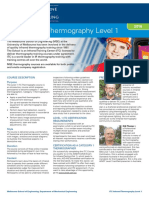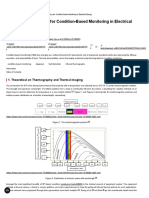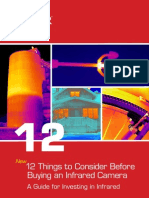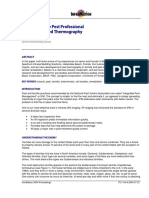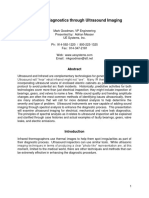100%(1)100% found this document useful (1 vote)
159 viewsInfrared Thermography at Refineries
Infrared Thermography at Refineries
Uploaded by
ayviwurbayviwurbInfrared thermography is widely used at oil refineries for maintenance and safety purposes. It allows refineries to detect electrical faults, heat losses, leaks, and failures in refractory linings that protect high-temperature equipment. Regular thermographic inspections of critical infrastructure like electrical systems and refractory linings can help refineries avoid unexpected shutdowns and identify maintenance issues before catastrophic failures occur, saving significant costs over time. While infrared thermography is an effective tool, some experts argue it is still underutilized at many refineries and could provide even greater cost savings if inspection programs were more standardized, frequent, and data-trending over time.
Copyright:
© All Rights Reserved
Available Formats
Download as PDF, TXT or read online from Scribd
Infrared Thermography at Refineries
Infrared Thermography at Refineries
Uploaded by
ayviwurbayviwurb100%(1)100% found this document useful (1 vote)
159 views2 pagesInfrared thermography is widely used at oil refineries for maintenance and safety purposes. It allows refineries to detect electrical faults, heat losses, leaks, and failures in refractory linings that protect high-temperature equipment. Regular thermographic inspections of critical infrastructure like electrical systems and refractory linings can help refineries avoid unexpected shutdowns and identify maintenance issues before catastrophic failures occur, saving significant costs over time. While infrared thermography is an effective tool, some experts argue it is still underutilized at many refineries and could provide even greater cost savings if inspection programs were more standardized, frequent, and data-trending over time.
Original Description:
Keeping the flame burning: Infrared
thermography at refineries
Original Title
Infrared thermography at refineries
Copyright
© © All Rights Reserved
Available Formats
PDF, TXT or read online from Scribd
Share this document
Did you find this document useful?
Is this content inappropriate?
Infrared thermography is widely used at oil refineries for maintenance and safety purposes. It allows refineries to detect electrical faults, heat losses, leaks, and failures in refractory linings that protect high-temperature equipment. Regular thermographic inspections of critical infrastructure like electrical systems and refractory linings can help refineries avoid unexpected shutdowns and identify maintenance issues before catastrophic failures occur, saving significant costs over time. While infrared thermography is an effective tool, some experts argue it is still underutilized at many refineries and could provide even greater cost savings if inspection programs were more standardized, frequent, and data-trending over time.
Copyright:
© All Rights Reserved
Available Formats
Download as PDF, TXT or read online from Scribd
Download as pdf or txt
100%(1)100% found this document useful (1 vote)
159 views2 pagesInfrared Thermography at Refineries
Infrared Thermography at Refineries
Uploaded by
ayviwurbayviwurbInfrared thermography is widely used at oil refineries for maintenance and safety purposes. It allows refineries to detect electrical faults, heat losses, leaks, and failures in refractory linings that protect high-temperature equipment. Regular thermographic inspections of critical infrastructure like electrical systems and refractory linings can help refineries avoid unexpected shutdowns and identify maintenance issues before catastrophic failures occur, saving significant costs over time. While infrared thermography is an effective tool, some experts argue it is still underutilized at many refineries and could provide even greater cost savings if inspection programs were more standardized, frequent, and data-trending over time.
Copyright:
© All Rights Reserved
Available Formats
Download as PDF, TXT or read online from Scribd
Download as pdf or txt
You are on page 1of 2
FLIR
APPLICATION
STORY
Keeping the flame burning: Infrared
thermography at refineries
Oil refineries are places where the black gold is heated up and cooled down
in order to produce its pricey derivatives. Production installations have to be
kept up and running to ensure a stable production and to satisfy the current high demand for oil products. Moreover, safety and plant reliability are
important issues, enhanced by tight environmental prescriptions.
A refinery plant is a rewarding object for
thermographic inspections. It exists of powerful
heating and cooling installations, such as fired
heaters and air coolers, electrical installations,
pumps and compressors, vessels, and endless
piping, thus offering opportunities at every step
to deploy a non-intrusive instrument such as an
infrared camera for inspection purposes.
HOW TO GET ON SUCCESSFULLY
There is general consensus about the huge payback of the application of infrared thermography at refineries and petrochemical production
plants. Including the results of thermal surveys
in the maintenance and shutdown planning
processes has been proven to bring significant
cost savings. Some corporations have worked
out guidelines to unify and streamline the
multitude of different applications and diverse
FLIR
Infrared image of a flare in daylight
infrared camera equipment.
The corporation bp, for example, has worked
out the following recommendations for a consistent thermography policy at its plants and
production sites :
standardize on one equipment manufacturer and software
identify and provide appropriate training
courses
generate in-house thermography procedures and specifications (including severity
criteria, frequency etc)
permanently investigate new thermography
applications and techniques
provide guidance to plants interested in
implementing an infrared thermography
program
Failure in internal refractory lining
What are the most important applications of
infrared thermography in the business and
where does the infrared camera excel as a
pro-active maintenance star and an operation
cost killer?
SURVEYING ELECTRICAL INSTALLATIONS
Electrical fault detection, transformer condition, distribution lines and substation inspections
have saved millions of dollars in cost savings
and cost avoidance, says John J. Nyholt,
Inspection specialist at bp, Houston, Texas
(US). Nyholt points to the term cost avoidance,
which is usually underestimated in cost calculations and relevant decision-making. Cost
avoidance is determined by the likelihood of
a failure to develop in a worst-case scenario,
such as an unscheduled shutdown, which
may have happened if the fault had not been
detected.
Andy Whitcher, Senior Consultant of UK-based
infrared thermography consulting company
Tecpinions, and an expert in thermographic
inspection of refineries, reports how his surveying of a substation air conditioning system, not
the most vital of functions at a refinery, identified a potential annual saving for his client of
USD 20,000 on his electricity bill.
DETECTING HEAT TRANSFER AND HEAT LOSS
The distribution of heat across coolers and
heat exchangers is an indicator of the condition of equipment. Thermography uncovers
poor heating and cooling, thus indicating a
waste of energy and improving the efficiency
of process operations. Infrared thermography
is also a valuable tool to detect heat loss from
steam traps and leaks.
Fugitive emissions of process liquids and
gases are a major concern for both the industry and national or supranational regulation
bodies. Calibrated FLIR Systems P-series cameras measure temperatures of up to 2,000C.
In addition, FLIR Systems GasFindIR, a camera
which rapidly detects fugitive gas emissions,
delivers real-time thermal images of gas leaks.
CONTROLLING REFRACTORY LINED EQUIPMENT
Refractory is an inner lining, consisting of hightemperature resistant materials which protect
the outer shell of piping, vessels, and process
furnaces from hot gases and fluids circulating
inside the plant. It is vital to a safe production
process: if the refractory lining fails, the steel-
made shell will quickly be weakened by heat
and internal pressure. This poses a significant
threat of failure of the equipment resulting in
loss of containment, environmental contamination and a significant risk of fires. Many
experts advise to inspect on a regular basis:
a long-term monitoring of refractory lining,
based on a regular inspection every week or
two weeks, leads to a detailed account of the
refractory behavior pattern and its resistance
features. This allows to manage the scheduling
of planned shutdowns to renew the lining, and
to avoid costly unplanned shutdowns, says
Andy Whitcher. Regular observation also enables plant engineers to improve the quality of
the employed refractory material.
TRACING SOLIDS BUILDUP
Buildup of solids is a result of refractory remnants or changes in process conditions. If ash
or other residues in furnaces or piping are not
detected they can result in unplanned shutdowns with lengthy and expensive searches
for the cause.
CONCLUSION: IR
INSPECTION POTENTIAL NOT
Growing buildup of deposits can be traced
USED TO CAPACITY
Thermal imaging is a very good indicator of
material, process and mechanical conditions at
refineries and petrochemical plants. However,
says Andy Whitcher, thermographic examination of fixed refinery equipment appears to be
under-utilized in the industry - and trending the
results over time adds to the huge cost savings:
it increases the refiners knowledge of the condition of his equipment, allowing him to make
more accurate and informed decisions.
IR might look expensive in terms of equipment,
training, condition monitoring program development and setup. But if used in conjunction with
a consistent infrared thermography program
and appropriate professional and reliable equipment, it will reach its full potential.
REFERENCES
NYHOLT, John J. Infrared Thermography in
BP Amoco Petrochemical Applications
in: Inframation 2001 Proceedings, Infrared
Training Center, Billerica, MA, USA
WHITCHER, Andy Thermographic Monitoring
of Refractory Lined Petroleum Refinery
Equipment in InfraMation 2004 Proceedings,
Infrared Training Center, Billerica, MA, USA
Refractory lining breakdown in an air line
For further information contact:
FLIR SYSTEMS LTD.
2 Kings Hill Avenue - Kings Hill
West Malling, Kent
ME19 4AQ
United Kingdom
Tel.: +44 (0)1732 221 245
Fax: +44 (0)1732 843 707
e-mail: sales@flir.uk.com
www.infracam.co.uk
You might also like
- Introduction To Thermography PrinciplesDocument72 pagesIntroduction To Thermography Principlesmsgjwhiteley100% (5)
- ITC Infrared Thermography 2016 Level 1Document2 pagesITC Infrared Thermography 2016 Level 1Ander Máximo Ulises100% (3)
- Set StandardsDocument83 pagesSet Standardsnikola5702100% (1)
- Industrial Applications of Infrared Thermography: How Infrared Analysis Can be Used to Improve Equipment InspectionFrom EverandIndustrial Applications of Infrared Thermography: How Infrared Analysis Can be Used to Improve Equipment InspectionRating: 4.5 out of 5 stars4.5/5 (3)
- Infrainspection Temperature StandardDocument18 pagesInfrainspection Temperature StandardMuhammadThoriqAzmiNo ratings yet
- Ir Familiarisation Book (Ir Level II N Book)Document17 pagesIr Familiarisation Book (Ir Level II N Book)Khaled Fatnassi50% (2)
- Thermal Pocket Guide / Infrared ThermographyDocument56 pagesThermal Pocket Guide / Infrared Thermographymdbeukel100% (5)
- Introduction To Infrared Thermography BasicsDocument29 pagesIntroduction To Infrared Thermography BasicsMiguel Alfonso Ruiz Mendez100% (2)
- Practical Guide: Electrical ThermographyDocument30 pagesPractical Guide: Electrical Thermographyinderhearth13No ratings yet
- Pocket Guide Thermography ENDocument29 pagesPocket Guide Thermography ENLOGITHASAN KRISHNANNo ratings yet
- Flir 12 Things To Consider Before Buying An Infrared CameraDocument19 pagesFlir 12 Things To Consider Before Buying An Infrared Cameramanu_chatNo ratings yet
- Thermal Imaging Tech ResourceDocument20 pagesThermal Imaging Tech Resourceskimav8650% (2)
- Motor PDM PrimerDocument4 pagesMotor PDM PrimerBoby100% (1)
- Leak Survey HandbookDocument11 pagesLeak Survey HandbookebbasinghNo ratings yet
- Thermalapplication Edu-Series PDFDocument95 pagesThermalapplication Edu-Series PDFMuamera HodzicNo ratings yet
- Cost of Applying I RDocument4 pagesCost of Applying I RMishkat Immaculate100% (1)
- Chimney: Measurements °CDocument3 pagesChimney: Measurements °Cநந்த குமார் சம்பத் நாகராஜன்No ratings yet
- Thermography Application NotesDocument95 pagesThermography Application NotesGabor100% (1)
- FLIR Green GuideDocument68 pagesFLIR Green Guidebq3410No ratings yet
- It0409 16 PDFDocument4 pagesIt0409 16 PDFAnthonio MJNo ratings yet
- Infrared Guidebook For Building Applications: An Informative Guide For The Use of Infrared in The Building IndustryDocument36 pagesInfrared Guidebook For Building Applications: An Informative Guide For The Use of Infrared in The Building IndustryRubyanne Cauchi100% (2)
- AEE - Northern Ohio - Stockton Infrared Presentation - SMDocument257 pagesAEE - Northern Ohio - Stockton Infrared Presentation - SMIuli BaicoianuNo ratings yet
- Better Infrared ThermographyDocument6 pagesBetter Infrared ThermographyAnonymous Wu6FDjbNo ratings yet
- MLE Study SubjectsDocument11 pagesMLE Study SubjectsMohsin MurtazaNo ratings yet
- 10 - 01 - 2007 - Kochanek - The Importance of Spatial Resolution in Infrared Thermography Temperature Measurements - 3 Brief Case StudiesDocument9 pages10 - 01 - 2007 - Kochanek - The Importance of Spatial Resolution in Infrared Thermography Temperature Measurements - 3 Brief Case Studieslbk50No ratings yet
- Emissivity and AccuracyDocument9 pagesEmissivity and Accuracyalexander100% (1)
- Fluke Thermography Presentation Feb21 PDFDocument78 pagesFluke Thermography Presentation Feb21 PDFkrushnaNo ratings yet
- "Infrared Thermography: Presented By: Kumar Kartikey 12EJAME048Document36 pages"Infrared Thermography: Presented By: Kumar Kartikey 12EJAME048surbhi pareekNo ratings yet
- 0-IR Equations PDFDocument175 pages0-IR Equations PDFJosé Juan Jiménez AlejandroNo ratings yet
- Introduction To Thermographic Analysis SKFDocument14 pagesIntroduction To Thermographic Analysis SKFTeckelino100% (1)
- Electrical System Inspection Theory and Thermal Signatures of ProblemsDocument12 pagesElectrical System Inspection Theory and Thermal Signatures of Problemsjide.atolagbe3737No ratings yet
- Building Thermography (Preview)Document36 pagesBuilding Thermography (Preview)Davide Lanzoni100% (2)
- Defining and Applying Severity CriteriaDocument4 pagesDefining and Applying Severity Criteriauamiranda3518100% (2)
- Blade Inspection MethodsDocument8 pagesBlade Inspection MethodsSivaNo ratings yet
- 12 Things To Consider Before Buying An Infrared Camera: A Guide For Investing in InfraredDocument19 pages12 Things To Consider Before Buying An Infrared Camera: A Guide For Investing in InfraredUchuk PabbolaNo ratings yet
- Thermography of Low Energy BuildingsDocument6 pagesThermography of Low Energy BuildingsSam WeberNo ratings yet
- Infrared Thermography 230 Pages Ebook - Electrical and Industrial ApplicationsDocument23 pagesInfrared Thermography 230 Pages Ebook - Electrical and Industrial ApplicationsDavide Lanzoni67% (6)
- Infrared Inspection DataDocument9 pagesInfrared Inspection DataAnonymous Wu6FDjb100% (1)
- Sample IR ReportDocument6 pagesSample IR ReportPrasanna Sinthaje100% (1)
- Application of IR - ITCDocument23 pagesApplication of IR - ITCJabranYounasNo ratings yet
- Why Is Thermography Testing of Electrical Panel Important?Document13 pagesWhy Is Thermography Testing of Electrical Panel Important?Itz AleshaGachaverse100% (1)
- Fluke Thermography Presentation Feb21Document78 pagesFluke Thermography Presentation Feb21matteo100% (1)
- Basics of InfraredDocument58 pagesBasics of InfraredConstantyn_FrederikNo ratings yet
- Thermography PDFDocument51 pagesThermography PDFSlim ShaddysNo ratings yet
- EPRI Ultrasound Assisted LubricationDocument39 pagesEPRI Ultrasound Assisted LubricationMahesh Kumar100% (1)
- Infrared Thermography BasicsDocument44 pagesInfrared Thermography Basicsdede100% (2)
- 2015-Infrared Thermography - Edi Wahyu SM-Ver.2.1 PDFDocument182 pages2015-Infrared Thermography - Edi Wahyu SM-Ver.2.1 PDFFatkhur Rokhman100% (2)
- Thermography Guide PDFDocument47 pagesThermography Guide PDFjuancrangelNo ratings yet
- Fluke 810Document148 pagesFluke 810Dwiki Juniarto HadiNo ratings yet
- T560451 enDocument8 pagesT560451 enrajatiitdNo ratings yet
- Applying Infrared ThermographyDocument4 pagesApplying Infrared ThermographyJaya DiNo ratings yet
- Iso 13373-9-2017Document30 pagesIso 13373-9-2017lucasaquinoengmeNo ratings yet
- Technical Seminar Documentation On ThermographyDocument16 pagesTechnical Seminar Documentation On ThermographyAkhila PallaNo ratings yet
- Intro To Building Diagnostic ThermographyDocument61 pagesIntro To Building Diagnostic Thermographygoguta gigelNo ratings yet
- CSI White PaperDocument13 pagesCSI White PaperJameel KhanNo ratings yet
- BASIC PRINCIPLES Non Contact Temperature MeasurementDocument40 pagesBASIC PRINCIPLES Non Contact Temperature MeasurementAkul BrigacNo ratings yet
- Infrared Thermography For Condition Monitoring - A ReviewDocument21 pagesInfrared Thermography For Condition Monitoring - A ReviewCarlos MartinsNo ratings yet
- Electrical Inspections With Thermal Imaging: ServicesDocument8 pagesElectrical Inspections With Thermal Imaging: ServicesV.g.MohanBabuNo ratings yet
- Toward An Ethics and Etiquette For Electronic MailDocument48 pagesToward An Ethics and Etiquette For Electronic MailayviwurbayviwurbNo ratings yet
- Mold Inspection ReportDocument8 pagesMold Inspection ReportayviwurbayviwurbNo ratings yet
- Thermography of MicrosystemsDocument14 pagesThermography of MicrosystemsayviwurbayviwurbNo ratings yet
- Using Infrared For Residential Energy SurveysDocument8 pagesUsing Infrared For Residential Energy SurveysayviwurbayviwurbNo ratings yet
- Lock in Thermography of Plasma Facing Components-Courtois ADocument12 pagesLock in Thermography of Plasma Facing Components-Courtois AalexanderNo ratings yet
- Thermography Applications in Technology ResearchDocument10 pagesThermography Applications in Technology ResearchayviwurbayviwurbNo ratings yet
- Asphalt Crack Detection Using ThermographyDocument12 pagesAsphalt Crack Detection Using ThermographyayviwurbayviwurbNo ratings yet
- Applying Infrared Imaging Techniques To Marine Surveying ... ContinuedDocument8 pagesApplying Infrared Imaging Techniques To Marine Surveying ... ContinuedayviwurbayviwurbNo ratings yet
- AIT RoofMoisture Example ReportDocument24 pagesAIT RoofMoisture Example ReportayviwurbayviwurbNo ratings yet
- Arion Green Office Building BrochureDocument8 pagesArion Green Office Building BrochureayviwurbayviwurbNo ratings yet
- Hybrid Ventilation ReviewDocument135 pagesHybrid Ventilation ReviewayviwurbayviwurbNo ratings yet
- Contents Page: Thermacam Reporter 2000 Professional - Template Building TutorialDocument10 pagesContents Page: Thermacam Reporter 2000 Professional - Template Building TutorialayviwurbayviwurbNo ratings yet
- Infrared Applications in The Fields of Forensic & Construction Defect EngineeringDocument8 pagesInfrared Applications in The Fields of Forensic & Construction Defect EngineeringayviwurbayviwurbNo ratings yet
- Flare Gas Monitoring SystemsDocument4 pagesFlare Gas Monitoring SystemsayviwurbayviwurbNo ratings yet
- FLIR B and T Series-EnDocument296 pagesFLIR B and T Series-EnayviwurbayviwurbNo ratings yet
- Three Ways The Pest Professional Can Use Infrared ThermographyDocument12 pagesThree Ways The Pest Professional Can Use Infrared ThermographyayviwurbayviwurbNo ratings yet
- Warehouse Asset ProtectionDocument4 pagesWarehouse Asset ProtectionayviwurbayviwurbNo ratings yet
- Mill Ladle Refractory MonitoringDocument4 pagesMill Ladle Refractory MonitoringayviwurbayviwurbNo ratings yet
- Night Sky Radiant Cooling - Influence On Outdoor Thermal Imaging AnalysisDocument18 pagesNight Sky Radiant Cooling - Influence On Outdoor Thermal Imaging AnalysisayviwurbayviwurbNo ratings yet
- Electric Substation MonitoringDocument4 pagesElectric Substation MonitoringayviwurbayviwurbNo ratings yet
- TNote Fog PDFDocument4 pagesTNote Fog PDFayviwurbayviwurbNo ratings yet
- Thermography SeminarDocument2 pagesThermography SeminarKiran Kumar GNo ratings yet
- TG-301 Thermal CameraDocument1 pageTG-301 Thermal CameraKarthik sankarNo ratings yet
- Provision-Isr General Catalog 2023Document73 pagesProvision-Isr General Catalog 2023VeroNo ratings yet
- What Is ThermalDocument2 pagesWhat Is Thermalzhungjian586No ratings yet
- Article 7-1-2006 RobinsonDocument18 pagesArticle 7-1-2006 RobinsonAnonymous Wu6FDjbNo ratings yet
- HSES CovidDocument58 pagesHSES CovidGerry MarrNo ratings yet
- Unit-2 Ii Drone Notes BW - 33907372 - 2024 - 05 - 26 - 07 - 39Document67 pagesUnit-2 Ii Drone Notes BW - 33907372 - 2024 - 05 - 26 - 07 - 39joinankitkumar03No ratings yet
- User's Manual FLIR Ex SeriesDocument56 pagesUser's Manual FLIR Ex SeriesHercules StyliarasNo ratings yet
- Resume PaperDocument8 pagesResume PaperMahmuda HairaNo ratings yet
- Magic TH 2020Document24 pagesMagic TH 2020Milon Kumar BishnuNo ratings yet
- Measurement of The Human Biofield and Other Energetic Instruments - Foundation For Alternative and Integrative Medicine PDFDocument39 pagesMeasurement of The Human Biofield and Other Energetic Instruments - Foundation For Alternative and Integrative Medicine PDFMarcus MacdonaldNo ratings yet
- FLiR E50Document8 pagesFLiR E50edcooNo ratings yet
- Lecture 4 - Heat Gain in BuildingDocument28 pagesLecture 4 - Heat Gain in BuildingZHI YI SOONo ratings yet
- T560 Series DatasheetDocument2 pagesT560 Series Datasheetgazi89No ratings yet
- FLIR T420, FLIR T420 Thermal Imaging Camera FLIR T 420Document2 pagesFLIR T420, FLIR T420 Thermal Imaging Camera FLIR T 420antoniabaxtermfxNo ratings yet
- Scott Sight FAQ 7524D en LowresDocument2 pagesScott Sight FAQ 7524D en LowresForum PompieriiNo ratings yet
- Presentation On Condition MonitoringDocument71 pagesPresentation On Condition MonitoringShahin Manjurul AlamNo ratings yet
- Cat ThermoMETER InfraredDocument56 pagesCat ThermoMETER InfraredspyrosNo ratings yet
- Browse: Irtek InternationalDocument4 pagesBrowse: Irtek InternationalAri PurnawanNo ratings yet
- I160 - User's ManualDocument58 pagesI160 - User's ManualRodrigo MouraNo ratings yet
- VuePro Users GuideDocument11 pagesVuePro Users GuideWachirarat Ton ChomchomeNo ratings yet
- FLIR CM275: Industrial Thermal Imaging Clamp Meter With Datalogging, Wireless Connectivity, and IGMDocument6 pagesFLIR CM275: Industrial Thermal Imaging Clamp Meter With Datalogging, Wireless Connectivity, and IGMEagle BangaloreNo ratings yet
- NDT For RenewablesDocument17 pagesNDT For RenewablesAvijit MondalNo ratings yet
- Level I Infrared Thermography Course OutlineDocument3 pagesLevel I Infrared Thermography Course OutlineElecol FajardoNo ratings yet
- Final Report of "Infrared Thermography To Failure Detection in Induction MotorsDocument31 pagesFinal Report of "Infrared Thermography To Failure Detection in Induction MotorsKarnam Thojeswar ChowdharyNo ratings yet
- Fluke Isee TC01A&TC01B Datasheet EN 202311Document4 pagesFluke Isee TC01A&TC01B Datasheet EN 202311Benny GomezNo ratings yet
- Fluke Pti120 Pocket Thermal Imager DatasheetDocument3 pagesFluke Pti120 Pocket Thermal Imager DatasheetGaneshkumarNo ratings yet
- PM & CM TrainingDocument29 pagesPM & CM TrainingSalman100% (1)
- Enhanced Diagnostics Through Ultrasound ImagingDocument11 pagesEnhanced Diagnostics Through Ultrasound ImagingAnonymous Wu6FDjbNo ratings yet
- IRT Consult EMEA Elec Mech Gas PPT PDFDocument88 pagesIRT Consult EMEA Elec Mech Gas PPT PDFRamakrishnan AmbiSubbiahNo ratings yet

